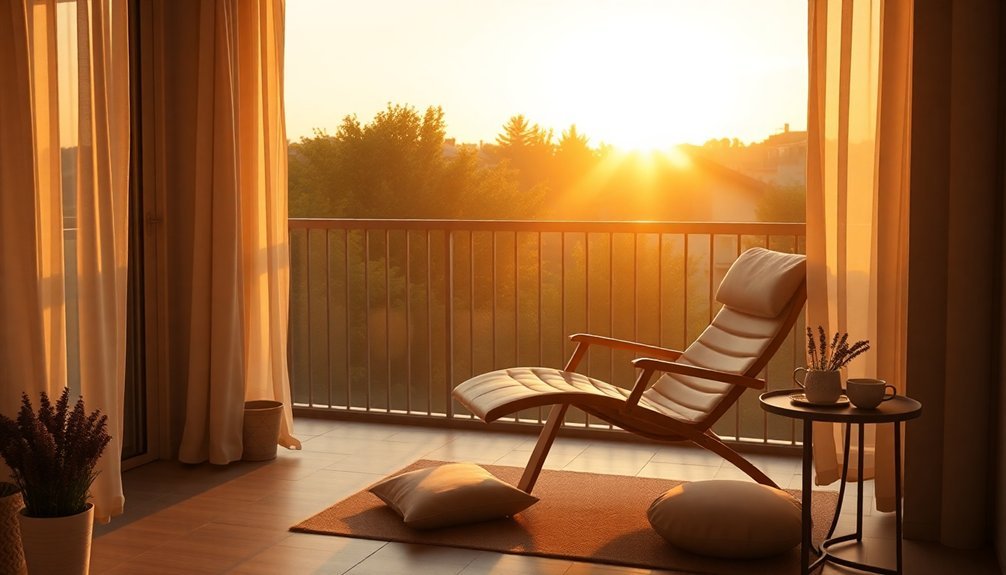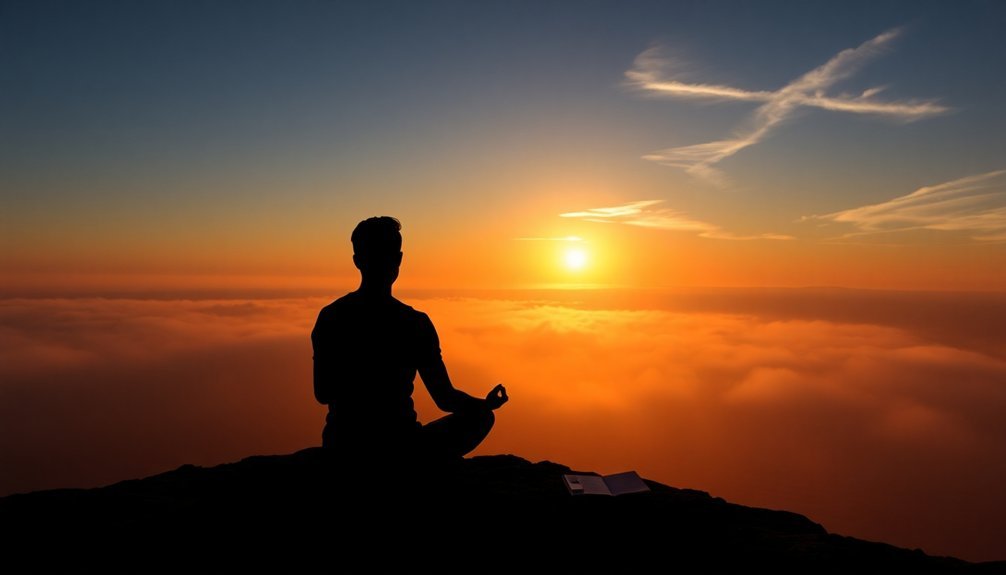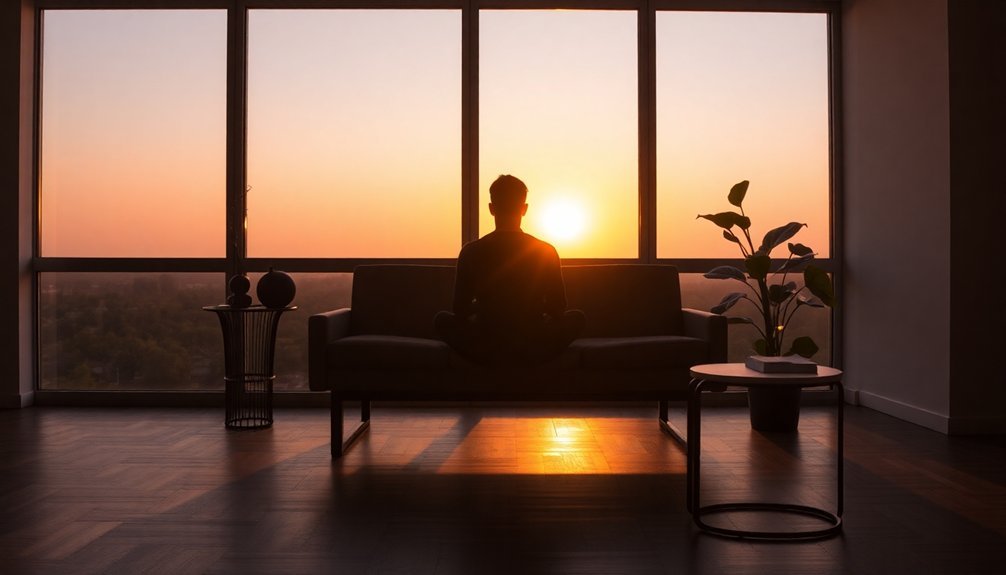The best time for light therapy depends on your sleep goals. If you want to wake up earlier, choose morning light exposure within 2-3 hours of waking – this advances your circadian rhythm. For later sleep times, evening light therapy works better by delaying your internal clock. Dawn-dusk simulation (DDS) therapy offers an automated approach that gradually adjusts light levels to match your schedule. You'll need 20-30 minutes minimum per session, but consistency matters more than duration. For ideal results, align your sessions with your natural sleep patterns rather than strict clock times. The science behind perfect timing reveals fascinating insights about your body's response to light.
Understanding Dawn and Dusk Therapy

Nature's rhythms guide our internal clocks, and Dawn-Dusk Simulation (DDS) therapy harnesses this natural pattern to improve sleep and circadian cycles. You'll find this therapy particularly beneficial if you're dealing with disturbed sleep patterns, especially in cases of dementia or similar conditions that affect your circadian rhythm.
DDS works by using a sophisticated system that mimics natural twilight phases. The therapy's effectiveness is enhanced by clear presentation methods that help patients better understand and follow the treatment protocol. You won't need to sit in front of a lightbox or require constant caregiver supervision, as the therapy uses an overhead halogen lamp controlled by a computer algorithm.
The system automatically adjusts light levels based on your location's latitude and longitude, creating realistic dawn and dusk experiences.
When you undergo DDS therapy, you'll experience gradual light changes that match your natural sleep-wake schedule. The system's careful calibration helps advance your main sleep episode while reducing unnecessary nighttime light exposure.
You'll likely notice improvements in your mood, especially during morning hours, and experience enhanced alertness throughout the day. This "naturalistic" approach effectively embeds sleep in its accustomed phase, making it an ideal choice for long-term treatment of sleep-wake disturbances.
Morning Light Benefits
While dawn and dusk therapy offers valuable benefits, morning light exposure stands out as a powerful natural tool for optimizing your health and well-being. You'll find that spending just 10-30 minutes in natural morning sunlight can transform your sleep quality and regulate your circadian rhythm more effectively than artificial light.
When you expose yourself to morning light, your brain starts producing serotonin, which enhances your mood and reduces your risk of depression. You'll notice improved cognitive function, better decision-making abilities, and increased alertness throughout your day. Regular morning sunlight exposure can increase cortisol levels by 35%, supporting healthy wakefulness.
The morning sun triggers your body to stop producing melatonin and start releasing cortisol, preparing you for daily activities.
To maximize these benefits, you should step outside shortly after sunrise without sunglasses for 5-10 minutes. Even on cloudy days, you'll receive more beneficial light than you'd indoors.
The morning light also helps regulate your appetite hormones and initiates vitamin D production, supporting your overall health. You'll find that establishing a consistent morning light routine can lead to better sleep patterns, reduced anxiety, and improved mental clarity.
Evening Light Advantages

Evening light exposure can boost your natural sleep patterns by helping reset your circadian rhythm through targeted melatonin adjustments.
The clear visual format helps you stay focused on tracking your evening light therapy progress.
You'll notice improvements in your sleep quality and duration as your body temperature cycle aligns with your desired schedule.
This shift in your internal clock makes evening light particularly beneficial if you're looking to adjust your sleep timing or manage night shift work schedules.
Natural Sleep Enhancement
Light's influence on our sleep patterns extends far beyond simple brightness and darkness. When you're looking to enhance your sleep naturally, evening light exposure can markedly impact your body's sleep-wake cycle. You'll find that carefully timed light therapy can delay your sleep onset and improve overall sleep quality.
| Light Type | Effect | Best Usage |
|---|---|---|
| Blue-depleted | Reduces melatonin suppression | Evening hours |
| Dim red | Promotes natural sleep onset | 2-3 hours before bed |
| Natural twilight | Entrains circadian rhythm | Sunset period |
To maximize these benefits, you'll need to take into account your individual characteristics, including age and chronotype. Using blue light blocking glasses or switching to blue-depleted lighting in the evening can help regulate your sleep hormones effectively. The timing and intensity of your light exposure matter substantially – consistency is key for maintaining healthy sleep patterns. Maintaining proper light exposure is essential since lack of sleep increases mortality risks significantly.
You can enhance these effects by combining light therapy with other sleep-promoting activities like infrared saunas or warm baths. Remember that while evening light therapy can be beneficial, it is crucial to adjust your exposure based on seasonal changes and your geographical location for the best results.
Circadian Rhythm Reset
Understanding your circadian rhythm's response to light gives you powerful tools for resetting your internal clock. When you want to shift your sleep schedule later, evening light exposure proves particularly effective, as it causes phase delays in your circadian system. This means you'll naturally feel sleepy later and wake up later.
You'll get the strongest effects from short-wavelength blue light (around 480 nm), which directly impacts your body's melatonin production. When you expose yourself to evening light, you'll suppress melatonin secretion, effectively pushing your sleep cycle later. This can be especially useful if you're trying to adjust to a later schedule, like preparing for travel across time zones westward.
However, you'll need to time your light exposure carefully. Light received before your core body temperature minimum will delay your circadian phase, while exposure after this point will advance it instead. For ideal results, you'll want to reflect on your current sleep patterns and adjust exposure accordingly.
Remember that your previous light exposure history affects how your body responds to subsequent light therapy, so consistency in timing matters for successful circadian rhythm adjustment.
Timing Your Light Treatment
The timing of your light therapy sessions can substantially impact their effectiveness. For the best results, you'll want to schedule your sessions about 2.5 to 3.5 hours after the midpoint of your sleep cycle. This timing aligns with approximately 8.5 hours after your natural melatonin onset.
You don't need to be an early riser to benefit from light therapy. Instead of focusing on clock time, you should base your sessions on your natural sleep patterns.
The Terman table can help you determine your ideal start time by considering your typical sleep onset and wake-up times.
While morning sessions have traditionally been preferred for pushing your internal clock forward, recent studies suggest that evening therapy can also be effective. Your individual circadian phase matters more than adhering to a standardized schedule. However, you'll want to avoid treatment too early, as it can push your clock backward, or too late in the morning when it may lose effectiveness.
The key is consistency. You'll get the best results by maintaining regular sleep patterns and following a treatment schedule that aligns with your personal circadian rhythm.
Natural Circadian Rhythm Effects

Your body's natural rhythms respond most strongly to light patterns throughout the day, with morning light pushing your sleep schedule earlier and evening light pushing it later.
You can reset your body clock by controlling when you're exposed to bright light, especially during the sensitive morning and evening periods.
The sleep-wake cycle works best when you maintain consistent daily light exposure and sleeping patterns, allowing your circadian pacemaker to properly regulate essential hormones like melatonin and cortisol.
Light Patterns Matter Most
Natural light patterns profoundly influence your body's circadian rhythm, making them essential for the best therapy timing. Your body's light sensitivity peaks during dawn and dusk, when the blue-to-yellow light ratios naturally shift. These twilight periods serve as critical anchors for your circadian system's entrainment.
You'll get the most benefit from morning light exposure, as it effectively resets your circadian system to local time. Your body is particularly responsive to short-wavelength blue light (around 460 nanometers) during this period, which helps regulate your cortisol and melatonin levels.
The longer you're exposed to bright morning light, the stronger the entrainment effect will be.
However, you'll want to avoid bright light exposure in the evening, as it can disrupt your sleep patterns. Evening light, especially from screens and artificial sources, suppresses melatonin production and delays sleep onset.
You're most sensitive to light intensity and duration during these hours, so even brief exposures can substantially impact your sleep quality. When planning therapy sessions, consider these natural light patterns to align with your body's biological rhythms and maximize therapeutic benefits.
Body Clock Reset Basics
Inside every human body ticks a powerful 24-hour clock that orchestrates essential biological functions. This internal timekeeper, known as your circadian rhythm, controls everything from your sleep patterns to hormone production, metabolism, and cognitive performance.
You can reset your body clock through several proven methods. Start by exposing yourself to natural morning light for at least 10 minutes – it's your body's strongest time-setting signal. Meanwhile, you'll want to limit bright light exposure, especially blue light from screens, in the evening hours as it disrupts your natural rhythm.
To maintain healthy circadian alignment, you'll need consistency in your daily routines. Keep your meal times regular, as they serve as important timing cues for your body. Exercise can help strengthen your circadian rhythm, but avoid vigorous workouts close to bedtime.
If you need to adjust your schedule, make gradual changes rather than dramatic shifts.
When your circadian rhythm stays properly aligned, you'll experience better sleep quality, improved cognitive function, and reduced risk of health issues like obesity and cardiovascular disease. If you're struggling with persistent rhythm disruptions, consider consulting a healthcare professional for personalized guidance.
Sleep-Wake Cycle Mechanics
The human body's sleep-wake cycle operates through an intricate dance of biological processes and chemical signals. Your brain's master clock, located in the suprachiasmatic nucleus, orchestrates this daily rhythm using specific neurotransmitters that either promote wakefulness or initiate sleep.
During your wakeful hours, your brain releases stimulating chemicals like acetylcholine, dopamine, and noradrenaline to keep you alert. As night approaches, sleep-promoting neurons release GABA, which gradually inhibits these wake-promoting regions, preparing you for rest.
| Time of Day | Brain Activity | Hormone Changes |
|---|---|---|
| Morning | Wake centers activate | Cortisol peaks |
| Afternoon | Sustained alertness | Cortisol decreases |
| Evening | Sleep signals increase | Melatonin rises |
Your circadian rhythm responds powerfully to light exposure, which helps maintain the timing of these processes. When you're exposed to natural light during the day, it reinforces your wake cycle, while darkness triggers melatonin production for sleep. This delicate balance affects not just your sleep quality but also your body temperature, immune function, and metabolism, making it vital to maintain consistent sleep-wake patterns for healthy well-being.
Sleep Quality Comparisons
When comparing sleep quality between those using dawn-dusk simulation (DDS) and control groups, significant differences emerge across multiple parameters. DDS users experience a notable 1:14h advance in their main sleep episode, along with shorter sleep latency, particularly among elderly patients with dementia. They also enjoy longer sleep duration and increased nocturnal immobility compared to those in control groups using dim red light.
The benefits of DDS become even more apparent when examining circadian rhythm markers. DDS strengthens your circadian rhythm, which directly impacts sleep quality and cognitive function. This is essential because weaker circadian rhythms often lead to daytime sleepiness and increased health risks, including cognitive impairment and multimorbidity.
If you're using DDS, you're likely to experience better morning mood and enhanced circadian stability. DDS exposure led to significantly better mood in the morning hours after waking, with the effects most pronounced in the second 4 weeks of DDS use, indicating that positive effects emerge gradually.
Even low-intensity DDS proves effective, as your circadian timing system remains responsive to light therapy regardless of age. For best results, you'll want to maintain long-term DDS application, as continuous use shows the most substantial improvements in sleep quality and overall well-being.
Mood Enhancement Results

Studies comparing dawn simulation with bright light therapy reveal striking mood enhancement results. You'll see impressive improvements in depression scores, ranging from 42.2% to 49.5% when using dawn simulation therapy.
The data shows that dawn simulation performs just as effectively as traditional bright light therapy in treating winter depression symptoms.
You can expect sustained mood improvements over a three-week treatment period, with many patients reporting high satisfaction levels.
What's particularly significant is that you'll experience these benefits through a more natural and less intrusive approach. The gradual light increase from 0.0003 to 250 lux mimics natural dawn, helping regulate your circadian rhythm without the eyestrain often associated with bright light therapy.
If you're considering treatment options, you'll find that dawn simulation stands out as a viable non-pharmacological alternative. The therapy's success rates match those of both bright light therapy and high-density negative air ionization.
You're likely to appreciate its natural action and compact device design, which patients consistently prefer over other treatment methods. The therapy's effectiveness, combined with its excellent safety profile, makes it a compelling choice for managing seasonal mood disorders.
Choosing Your Therapy Time
Deciding on therapy frequency comes down to several key factors that shape your treatment journey. Your specific type of therapy, the severity of your concerns, and your financial situation all play essential roles in determining how often you'll meet with your therapist.
You'll likely need more frequent sessions during the initial stages of therapy to build a strong therapeutic relationship. While weekly sessions are common, you and your therapist should work together to find a schedule that fits your unique needs.
Some clients do well with bi-weekly sessions, especially as they progress in their treatment.
Your therapy sessions should have clear goals and objectives tailored to your needs. You'll find that treatment length varies substantially based on your presenting issues. While some concerns might resolve in 12-30 sessions, you may need longer treatment if you're dealing with complex or chronic conditions.
Remember that you're not locked into a specific frequency. As you progress through therapy, you and your therapist can adjust the session schedule to match your evolving needs and progress toward your therapeutic goals.
Research-Backed Treatment Windows

Recent research has illuminated the ideal treatment windows for different types of light therapy.
Bright light therapy proves most effective when used as an adjunct treatment alongside antidepressants, requiring higher light intensity (over 2,500 lux) for best results in treating winter-SAD symptoms.
For dawn simulation, you'll want to focus on the early morning hours when the therapy can naturally mimic sunrise. The gradual increase in light intensity helps regulate your circadian rhythm more effectively than sudden bright light exposure. If you're dealing with subsyndromal-SAD or sleep disturbances, this gentler approach might work better for you.
When it comes to dynamic daylight conditions, particularly for brain injury recovery, you'll benefit from consistent exposure throughout the day to maintain stable circadian rhythms.
You should consider that while dusk simulation is less researched, it's often combined with dawn simulation for complete circadian rhythm regulation, especially if you're dealing with dementia-related sleep disturbances.
The key is matching the therapy timing to your specific condition, whether it's SAD, non-seasonal depression, or circadian rhythm disorders.
Optimal Light Exposure Duration
You'll need a minimum of 2000 lux of light exposure to effectively regulate your circadian rhythm and seasonal patterns.
For most adults, aim to get 20-30 minutes of direct morning sunlight within two hours of waking up, though you can start with shorter durations and gradually increase your exposure time.
If you're getting light through a car windshield or window, double your exposure time since filtered light is roughly 50% less effective for therapeutic benefits.
Light Intensity Thresholds
Finding the right light intensity for therapeutic purposes boils down to a delicate balance. For the most effective skin effects, you'll need at least 20mW/cm², but it's best to stay under 50mW/cm² to prevent skin hyperthermia. The sweet spot typically falls between 30-35mW/cm², which closely mimics natural sunlight in the Red/NIR spectrum.
You'll want to aim for doses between 0.1J/cm² and 6J/cm² for cellular effects, though deeper systemic benefits might require up to 70J/cm² or more. If you're using LED devices, stick to power densities below 100mW/cm², as higher intensities can lead to photoaging and potential tissue damage.
When it comes to circadian effects, you'll need to be particularly mindful of intensity levels. Even dim light between 5-30 lux can substantially impact your body's internal clock. You'll need to adjust the intensity based on the time of day – what works in the morning might be too intense for evening exposure.
Remember that your body's sensitivity to light varies throughout the day, so you'll want to reduce intensity levels as evening approaches to maintain healthy circadian rhythms.
Treatment Length Guidelines
When establishing ideal light therapy durations, a standard three-week treatment period has emerged as the baseline guideline.
During this time, you'll need to maintain consistent daily exposure, with each session involving 30-minute gradual adjustments for both dawn and dusk phases.
You'll find that the timing needs to be precisely fitted to your sleep schedule, as this helps enhance the therapy's effectiveness. While you're undergoing treatment, you won't need constant supervision or active participation, unlike traditional bright light therapy sessions. This makes it easier to maintain compliance throughout the three-week period.
To achieve the best results, you should expect the process to work gradually at a biochemical level. Don't anticipate immediate effects; instead, understand that the benefits build up over the treatment period.
You'll typically notice improvements in sleep onset and quality, particularly if you're an elderly patient with dementia-related sleep issues. The three-week duration has shown significant benefits compared to placebo conditions, though your healthcare provider might adjust this timeframe based on your specific needs and response to the treatment.
Treatment Success Factors

Several key factors determine the success of light therapy treatment. You'll achieve the best results by focusing on proper timing, intensity, and consistency of your sessions. Morning light therapy proves most effective for treating depression and advancing sleep phase, while evening sessions may help if you need to delay your sleep timing.
| Success Factor | Key Consideration |
|---|---|
| Timing | Morning sessions best for depression and phase advance |
| Light Intensity | 5,000-10,000 lux for standard bright light therapy |
| Duration | Minimum 30 minutes daily, with 3 weeks for initial results |
| Consistency | Ongoing treatment needed to maintain benefits |
| Safety Protocol | Professional guidance for bipolar/eye conditions |
Your treatment success also depends on following safety guidelines and monitoring for side effects. If you experience headaches, eyestrain, or nausea, you can usually resolve these by reducing exposure time or increasing your distance from the light source. For the best results, you'll need to maintain your treatment schedule long-term, as benefits typically don't persist beyond the exposure period. If you have bipolar disorder, you'll need careful monitoring, as light therapy can trigger manic episodes in some cases.
Frequently Asked Questions
Can Dawn-Dusk Therapy Interfere With Certain Medications or Medical Conditions?
You'll want to consult your doctor, as medication timing can affect drug interactions and medical conditions. While specific dawn-dusk interactions aren't well-documented, proper scheduling of your medications remains essential for safety.
What's the Minimum Light Intensity Needed for Effective Dawn-Dusk Simulation?
You'll need a minimum light intensity of 0.001 lux for effective dawn-dusk simulation. This matches natural twilight conditions and is enough to trigger your circadian timing system's response to light therapy.
How Long Should Someone Wait Between Switching From Dawn to Dusk Therapy?
You'll need to wait at least 2-3 weeks before switching from dawn to dusk therapy. Give your body time to stabilize its circadian rhythm and monitor your response before making the change.
Are There Specific Eye Conditions That Make Dawn-Dusk Therapy Unsuitable?
You shouldn't use dawn-dusk therapy if you have achromatopsia, severe photophobia, or advanced macular degeneration. It's also risky if you're dealing with retinitis pigmentosa or active diabetic retinopathy.
Does Caffeine Consumption Affect the Effectiveness of Dawn-Dusk Light Therapy?
Yes, your caffeine intake can reduce light therapy's effectiveness. When you consume caffeine, it disrupts your natural sleep patterns and circadian rhythms, potentially interfering with the benefits you'd normally get from dawn-dusk light therapy.
In Summary
You'll get the most from light therapy by matching treatment time to your sleep-wake patterns and specific condition. For depression, morning light works best, while evening exposure helps night owls adjust their schedules. Whether you choose dawn or dusk therapy, stick to consistent timing and aim for 20-30 minutes of exposure. Track your results and adjust your schedule until you find your ideal treatment window.





Leave a Reply